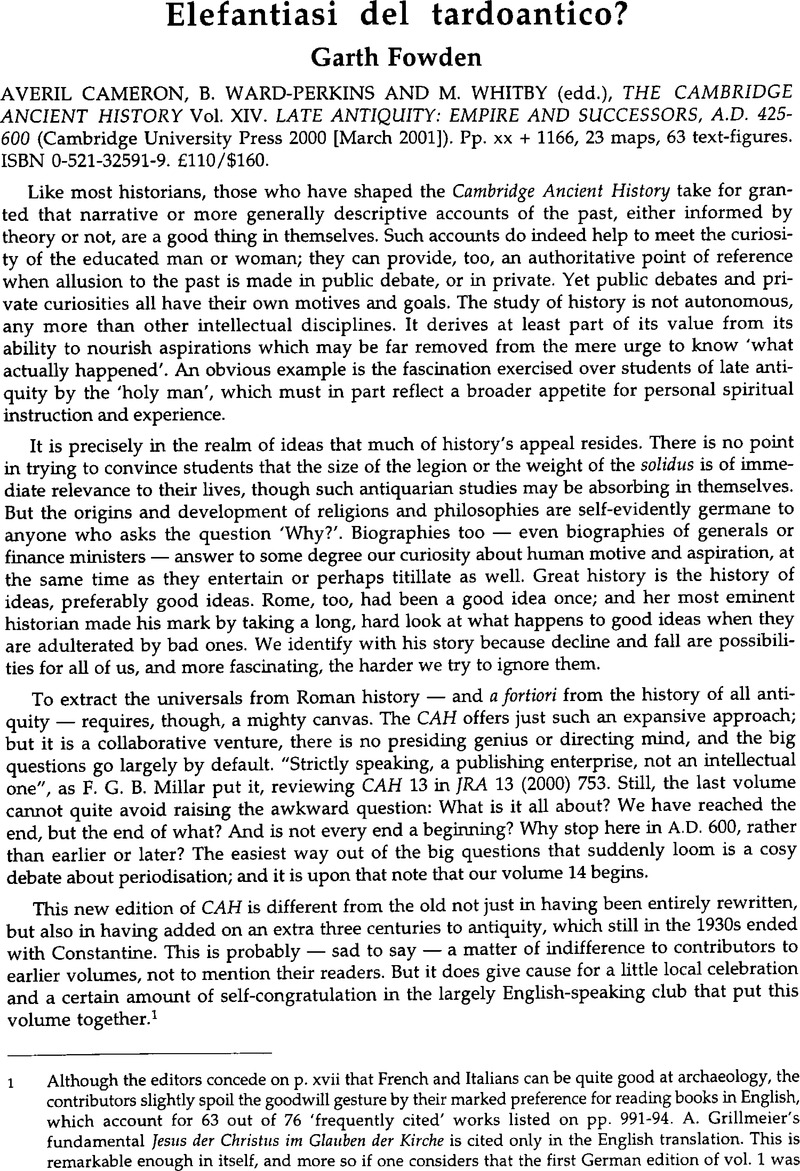Article contents
Elefantiasi del tardoantico? - Averil Cameron, B. Ward-Perkins and M. Whitby (edd.), THE CAMBRIDGE ANCIENT HISTORY Vol. XIV. LATE ANTIQUITY: EMPIRE AND SUCCESSORS, A.D. 425-600 (Cambridge University Press 2000 [March 2001]). Pp. xx + 1166, 23 maps, 63 text-figures. ISBN 0-521-32591-9. £110/$160.
Published online by Cambridge University Press: 16 February 2015
Abstract

- Type
- Reviews
- Information
- Copyright
- Copyright © Journal of Roman Archaeology L.L.C. 2002
References
1 Although the editors concede on p. xvii that French and Italians can be quite good at archaeology, the contributors slightly spoil the goodwill gesture by their marked preference for reading books in English, which account for 63 out of 76 ‘frequently cited’ works listed on pp. 991-94. A. Grillmeier's fundamental Jesus der Christus im Glauben der Kirche is cited only in the English translation. This is remarkable enough in itself, and more so if one considers that the first German edition of vol. 1 was published four years after the second English edition (1975) and was much expanded, while the third German edition was further updated and corrected.
2 Note, though, that the editors' preface to CAH 13 draws attention to the importance of “the church as a public institution”, and even the “monastic movement”, but avoids reference to doctrine, spirituality or — of course — Fathers.
3 On which cf. Said, E., Orientalism (London 1978) 302–3Google Scholar: “no corporate idea of itself as a history … ideas and methodological intelligence are almost entirely absent … written for the most part in a ghastly monotone”. It would be daring to argue that the Cambridge formula has evolved toto caelo since the 1960s, when both the CHI and the earliest volumes of CAH 2 were produced. Most damaging of all is Said's comment on the majority of contributors' failure to make Islamic religion and culture seem in any way interesting.
4 One contributor is candid — not ironical — enough to admit that he aspires to be no more than a “pale imitation” of Jones: 731 n.1.
5 The unattributed Conclusion must be assumed to be the joint responsibility of the three editors. In the mini-symposium that followed Liebeschuetz's, J. H. W. G. “The uses and abuses of the concept of ‘decline’ in later Roman history, or, Was Gibbon politically incorrect?” in Lavan, L. (ed.), Recent research in late-antique urbanism (JRA Suppl. 42, 2001) 233–45Google Scholar, Averii Cameron finds the concept of decline “far too emotive to be useful”, while B. Ward-Perkins opines that “the ancient world ended and … this was essentially a ‘bad thing’”.
- 1
- Cited by


